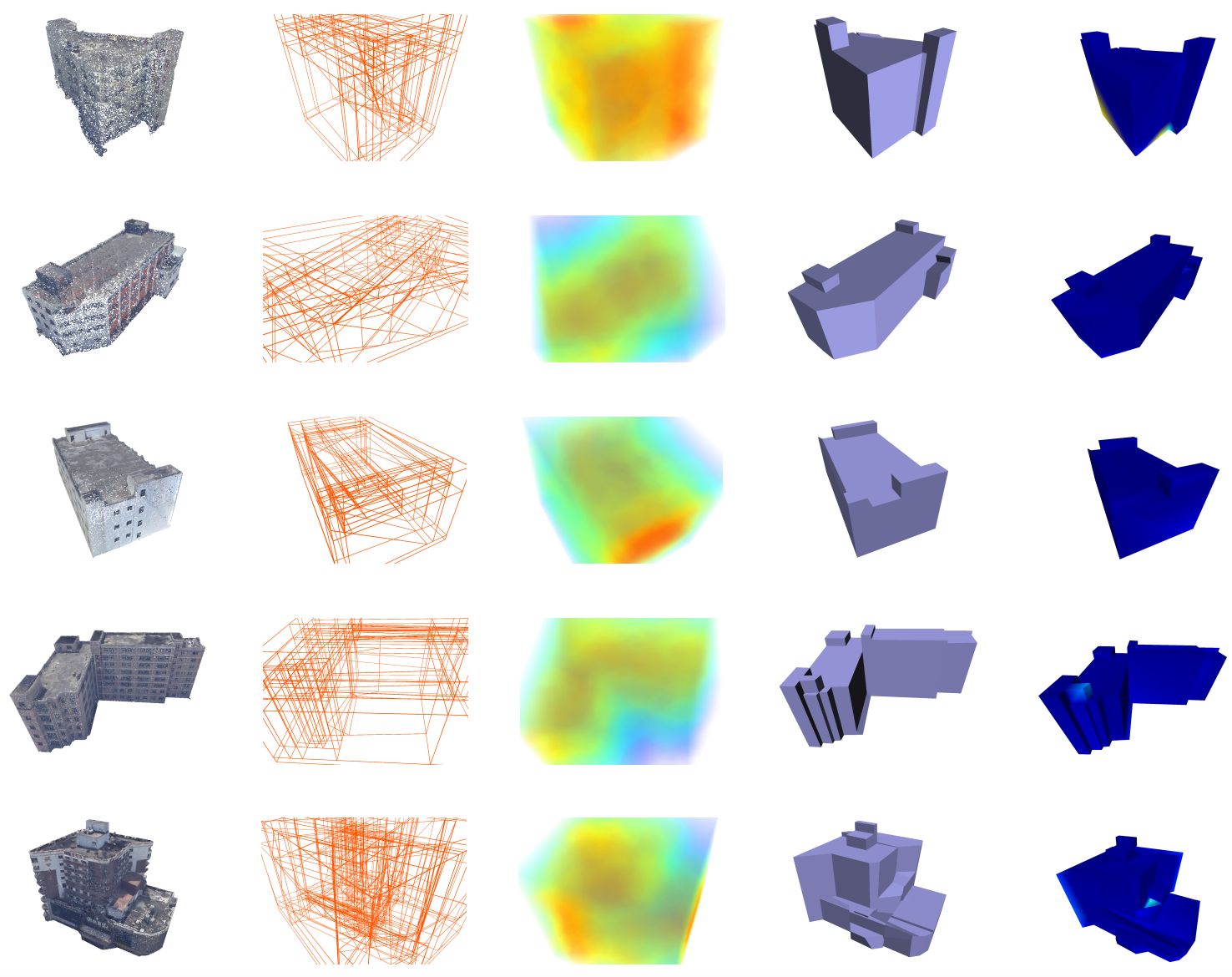https://github.com/chenzhaiyu/points2poly
Reconstructing compact building models from point clouds using deep implicit fields [ISPRS 2022]
https://github.com/chenzhaiyu/points2poly
3d building implicit-field point-cloud reconstruction
Last synced: 6 months ago
JSON representation
Reconstructing compact building models from point clouds using deep implicit fields [ISPRS 2022]
- Host: GitHub
- URL: https://github.com/chenzhaiyu/points2poly
- Owner: chenzhaiyu
- License: mit
- Created: 2021-02-08T20:43:37.000Z (over 4 years ago)
- Default Branch: main
- Last Pushed: 2023-12-29T15:33:57.000Z (almost 2 years ago)
- Last Synced: 2024-05-06T00:02:57.712Z (over 1 year ago)
- Topics: 3d, building, implicit-field, point-cloud, reconstruction
- Language: Python
- Homepage: https://github.com/chenzhaiyu/points2poly
- Size: 1.28 MB
- Stars: 161
- Watchers: 12
- Forks: 28
- Open Issues: 1
-
Metadata Files:
- Readme: README.md
- License: LICENSE
- Citation: CITATION.bib
Awesome Lists containing this project
README
# Points2Poly
-----------
## Introduction
***Points2Poly*** is an implementation of the paper [*Reconstructing Compact Building Models from Point Clouds Using Deep Implicit Fields*](https://www.sciencedirect.com/science/article/pii/S0924271622002611), which incorporates learnable implicit surface representation into explicitly constructed geometry.

Due to clutter concerns, **the core module is separately maintained in the [*abspy*](https://github.com/chenzhaiyu/abspy) repository** (also available as a [PyPI package](https://pypi.org/project/abspy/)), while this repository acts as a wrapper with additional sources and instructions in particular for building reconstruction.
## Prerequisites
The prerequisites are two-fold: one from `abspy` with functionalities on vertex group, cell complex, and adjacency graph; the other one from `points2surf` that facilitates occupancy estimation.
Clone this repository with submodules:
```bash
git clone --recurse-submodules https://github.com/chenzhaiyu/points2poly
```
In case you already cloned the repository but forgot `--recurse-submodules`:
```bash
git submodule update --init
```
### Requirements from `abspy`
Follow the [instruction](https://github.com/chenzhaiyu/abspy#installation) to install `abspy` with its dependencies, while `abspy` itself can be easily installed via [PyPI](https://pypi.org/project/abspy/):
```bash
# local version (stable)
pip install ./abspy
# PyPI version (latest)
pip install abspy
```
### Requirements from `points2surf`
Install the dependencies for `points2surf`:
```bash
pip install -r points2surf/requirements.txt
```
For training, make sure CUDA is available and enabled.
Navigate to [`points2surf/README.md`](https://github.com/ErlerPhilipp/points2surf) for more details on its requirements.
In addition, install dependencies for logging:
```bash
pip install -r requirements.txt
```
## Getting started
### Reconstruction demo
Download a mini dataset of 6 buildings from the [Helsinki 3D city models](https://kartta.hel.fi/3d/), and a pre-trained full-view model:
```bash
python download.py dataset_name='helsinki_mini' model_name='helsinki_fullview'
```
Run reconstruction on the mini dataset:
```bash
python reconstruct.py dataset_name='helsinki_mini' model_name='helsinki_fullview'
```
Evaluate the reconstruction results by Hausdorff distance:
```bash
python evaluate.py dataset_name='helsinki_mini'
```
The reconstructed building models and statistics can be found under `./outputs/helsinki_mini/reconstructed`.
### Helsinki dataset
Download the Helsinki dataset from [OneDrive](https://1drv.ms/f/s!AseUjD457t0Sgtptq5PZlrPBwu8N_A?e=mvtSrw), including meshes, point clouds, and queries with distances.
### Custom dataset
#### Reconstruction from custom point clouds
* **Convert point clouds into NumPy binary files** (`.npy`). Place point cloud files (e.g., `.ply`, `.obj`, `.stl` and `.off`) under `./datasets/{dataset_name}/00_base_pc` then run [`points2surf/make_pc_dataset.py`](https://github.com/ErlerPhilipp/points2surf/blob/master/make_pc_dataset.py), or manually do the conversion.
* **Extract planar primitives from point clouds with** [Mapple](https://github.com/LiangliangNan/Easy3D/releases/tag/v2.5.2). In Mapple, use `Point Cloud` - `RANSAC primitive extraction` to extract planar primitives, then save the vertex group files (`.vg` or `.bvg`) into `./datasets/{dataset_name}/06_vertex_group`.
* **Run reconstruction the same way as that in the demo**. Notice that, however, you might need to retrain a model that conforms to your data's characteristics.
#### Make training data
Prepare meshes and place them under `datasets/{dataset_name}` that mimic the structure of the provided data. Refer to this [instruction](https://github.com/ErlerPhilipp/points2surf#make-your-own-datasets) for creating training data through [BlenSor](https://www.blensor.org/) simulation.
## TODOs
- [x] Separate `abspy`/`points2surf` from `points2poly` wrappers
- [x] Config with hydra
- [x] Short tutorial on how to get started
- [x] Host generated data
## License
[MIT](https://raw.githubusercontent.com/chenzhaiyu/points2poly/main/LICENSE)
## Acknowledgement
The implementation of *Points2Poly* has greatly benefited from [Points2Surf](https://github.com/ErlerPhilipp/points2surf). In addition, the implementation of the *abspy* submodule is backed by great open-source libraries inlcuding [SageMath](https://www.sagemath.org/), [NetworkX](https://networkx.org/), and [Easy3D](https://github.com/LiangliangNan/Easy3D).
## Citation
If you use *Points2Poly* in a scientific work, please consider citing the paper:
```bibtex
@article{chen2022points2poly,
title = {Reconstructing compact building models from point clouds using deep implicit fields},
journal = {ISPRS Journal of Photogrammetry and Remote Sensing},
volume = {194},
pages = {58-73},
year = {2022},
issn = {0924-2716},
doi = {https://doi.org/10.1016/j.isprsjprs.2022.09.017},
url = {https://www.sciencedirect.com/science/article/pii/S0924271622002611},
author = {Zhaiyu Chen and Hugo Ledoux and Seyran Khademi and Liangliang Nan}
}
```